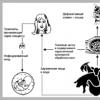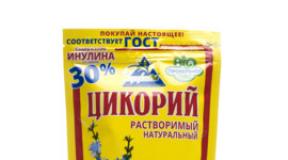Youth newspapers and magazines. The teenager and the modern market of children's magazines. For Serious Readers
At the same time, new editions continue to enter the market today. In 2003, the magazine "Yes! Factory of Stars" appeared (now it is called "Yes! Stars"), in 2004 - Teens, "Factory", Bravo.Posters. In May 2005, the SPN-Media publishing house, together with the TNT television channel, began publishing the Reality Show Dom 2 magazine. The 100,000th edition of the first issue, according to Dmitry Naida, deputy chief editor of Reality Show Dom 2, was sold on the first day. Now the circulation of the magazine is already 600 thousand copies.
The entry of publications into the segment of the teenage and youth press is ensured primarily by their audience: the age of readers is 12-24 years old, the core is 14-17 years old. The leaders in the youth press market today are publications that appeared in the post-Soviet era, in the 90s and early 2000s. Thus, in terms of audience coverage (AIR), 10 publications were included in the TNS Gallup Media rating as of April 2005 (see diagram). In this material, we consider magazines with a coverage of the Moscow press audience of more than 1% - these are Yes! Stars, Yes!, Hammer, Hooligan, Oops!, Cool, Cool Girl, Elle Girl. The segment of youth and near-youth magazines partly includes music (Bravo.Posters, Rolling Stone) and computer publications (PC Games, Igromania, etc.). But we do not consider them because of the narrower focus and coverage of the Moscow audience is less than 1%.
The publishers note that the youth press market is now in an active phase of development. In their opinion, the peak of popularity of this segment is yet to come, because the mass consumer culture is still being formed. At the same time, according to the State Statistics Committee, the number of births in the country is falling (in 1990, about 2 million people were born, and in 2003 - less than 1.5 million) - the number of potential readers of publications for teenagers and youth is correspondingly decreasing. Margarita Luchina, NRS Project Manager, TNS Gallup Media: "We can hardly expect a strong increase in the audience of youth magazines - the number of this group is decreasing from year to year. The reason is the demographic crisis in Russia."
The popularity of youth publications may also be affected by the rapid development of the Internet. Alexander Efremov, head of the press audience research group at the Video International analytical center: "Electronic and new media in 3-4 years can" grab "a significant chunk of the audience of the youth press. Why? under the influence of the Internet is more visible among young people. Therefore, youth publications will lose their audience at a faster rate than other newspapers and magazines.
According to TNS Gallup AdFact, the TOP-100 publications in terms of advertising space in magazines for the period January - April 2005 (Moscow) included three youth magazines - Molotok (56th place), Cool (69th place), and Elle Girl (88th).
SPECIES AND SUB-SPECIES
The teenage and youth audience is a very specific segment. On the one hand, this is one of the most easily seduced part of the population by high-profile brands. On the other hand, compared to adults, they have a lower purchasing power. In addition, if adults are interested in the same topics at 25, 35 and 45 years old, teenagers change their preferences much more often. And they more categorically rebuild themselves from those around them by age and gender. Accordingly, magazines are also forced to focus on these audience groups.
As for age, publishers and researchers distinguish two groups. The first is teenagers aged 12-16 (middle and high school students, the upper limit is graduation from school). Cool and Molotok are more focused on this audience than others. The second group is young people aged 16-24. In turn, the second group is also conditionally divided into junior students (16-20 years old) and senior students (20-24 years old). Senior students often already have an independent income and are financially independent from their parents. This is a transitional audience from youth magazines to adults, and therefore not very numerous. Girls with Elle Girl tend to move to women's magazines. And young people - from "Hooligan" to men's, automotive, computer, etc. The sub-segment of teenage magazines includes Cool, Cool Girl, "Hammer", youth - Oops!, Elle Girl, Yes!, "Yes! Stars", "Hooligan ".
By gender, publishers segment the press for teenagers and youth in this way. Universal magazines: "Hammer" and Cool; boys: "Hooligan"; for teenage girls: Cool Girl; for older girls - Oops, Elle Girl, Yes!, and "Yes! Stars"
YOUTH CONTENT
Teenage and youth magazines most often build trusting relationships with the reader (the magazine is a close friend). Ilya Burets, Marketing and PR Manager Yes! and "Yes! Stars": "The magazine can somehow replace parents, answer questions that a teenager is embarrassed to ask the adults around him, for example, body care, sex. Regardless of what is happening in the country and the world, a youth magazine always writes more about cultural events, introduces the reader to the news of the world of music, cinema, fashion trends.
“Young people are primarily interested in musicians and actors,” says Ekaterina Mil, editor-in-chief of the Molotok magazine. “Second Echelon” - athletes, models, and other heroes of gossip columns. "No less teenagers are concerned about issues of survival in society (relations with parents and the opposite sex; police, army, aggression at school, choosing a future profession). Girls love horoscopes, fortune-telling and tests. Thus, all youth magazines presented on the Russian market, can definitely be called musical or near-musical, and the rest of the content is determined by the editors based on the characteristics of their audience."
According to Sergei Vereikin, editor-in-chief of Cool magazine, youth publications are distinguished from other press by a non-academic style of presentation and presentation of materials. Lexically, they are characterized by youth slang ("break away", "party", "party") on the verge of literary and colloquial language. The authors communicate with their readers on "you", although they assure that they are trying not to slide into familiarity.
Standard thematic blocks of youth magazines:
- news, rumors, gossip and scandals of show business;
- interviews with "youth" stars - Britney Spears, Dima Bilan, numerous manufacturers, etc.;
- new names in music, new styles and trends;
- youth fashion: make-up, clothes;
- psychology, love stories, gender relations (sex and everything connected with it);
- professional orientation;
- the problem of earning and accumulating money;
- extreme sports, travel;
- tests, horoscopes, anecdotes, crossword puzzles.
As for the design of youth magazines, they are distinguished by an abundance of posters, large photographs, colorful takeaways and other bright, eye-catching elements.
YES! STARS
Published since October 2003. At first, the magazine was called "Yes! Star Factory" and was published jointly with Channel One. The editors say that it was a mutual decision of the publishing house and television. The main characters of the publications were and still are the participants of the TV project of the same name.In March 2005, the magazine was renamed and is now published under the name "Yes! Stars". According to the publisher, this is due to the end of the television project in December 2004. However, the central theme of each issue is still the life of "manufacturers", as well as other young stars of Russian and foreign show business (they are given approximately equal attention). The release of the magazine in support of the popular TV project turned out to be in demand - its circulation from November 2003 to November 2004 increased more than seven times - from 100 thousand copies to 747 thousand. Now the circulation has decreased due to the end of the TV project.
Publishing House: Independent Media
Publisher: Margarita Tyrina, editorial director Irina Ilyina, editor-in-chief Sergey Oleshchenko
Periodicity: monthly (release day 17-19th)
Volume: 84 stripes
Claimed edition: 450 thousand copies
Core Audience*: mostly (78.3%) female students aged 16-24
Spreading: So far, the magazine can only be purchased at retail. 34.5% of the circulation is sold in Moscow, 58.1% - in all Russian regions and 7.4% - in the CIS and Baltic countries. From January 2006 the magazine will be distributed by subscription.
Major advertisers in 2005**: Big-Bon, Clean & Clear, i-Free, Infon, L "Oreal, Mentos, Nikita, Samsung, Siemens, Smx-Com
YES!
The magazine began publishing in Russia in September 1998; it is a completely Russian product, invented by Igor Shein, who is now the editor-in-chief of the Robb Report magazine. In September 2004, Yes! completely switched to a mini-format (A5 size). According to Margarita Tyrina, the magazine's publisher, this is a more convenient format. She notes that thanks to the format change, it was possible to increase circulation by 40% during 2004. The design and content of the magazine also changed, more special projects appeared, for example, in October 2004 a double issue was released, one half of which was called Yes (for good girls), and the second - No (for bad girls). The November issue was 100% devoted to boys. CDs, readers' cards, etc. are also regularly attached to the magazine. Publishers are positioning Yes! like "your first glossy magazine".Publishing House: Independent Media
Publisher: Margarita Tyrina, editorial director Tatyana Gevorkyan, editor-in-chief Irina Ilyina
Periodicity: monthly (release day: 1st)
Claimed edition: 160 thousand copies
Volume: 148 stripes
Core Audience: mostly girls aged 16-24, high school students of secondary educational institutions and universities (family income is average and above average)
Spreading: 97.3% - retail (50.5% of the circulation is sold in Moscow, 42.6% - in all regions of Russia, 4.3% - in the CIS and Baltic countries), 2.7% - subscription
Chanel Group, Jamilco, Johnson & Johnson, IFD, i-Free, L "Oreal, Mexx, Nike, Procter & Gamble, Samsung
HAMMER
Published since 1999. For the first two years the magazine was published in A3 format, since 2002 - in A4 format. According to Ekaterina Mil, editor-in-chief of Molotok, this format is more convenient for reading and working with advertisers. Since the end of 2002, a separate publication has been published in A3 format - the magazine "Plakaty Molotok" (16-24 pages). The central poster of "Hammer Posters" is a two-sided A1 poster. Since June 2003, the Molotok Publishing House has been publishing the magazine, the 100% owner of which is the Kommersant Publishing House. Since November 2004, Molotok has increased the number of pages from 48 to 56.The magazine is intended for boys and girls almost equally. The Hammer contains a lot of information about show business, interviews with young Russian and foreign stars (Macaulay Culkin, Stas Piekha). Topics covered are relationships with parents, in a group, etc. Lexical features: in the "Hammer" most of all youth slang.
The magazine sponsors various musical events - festivals "Invasion", "Chart Dozen", "Bomb of the Year", MTV RMA 2004 awards ceremony, concerts of Rasmus, Garbage, Rammstein, "Beasts", Smash !!, tATu, punk, dance , rap festivals.
Publishing House: "Hammer"
Chief Editor: Ekaterina Mil
Periodicity:
Claimed edition: 215 thousand copies
Volume: 56 stripes
Core Audience: girls (52%) and young people (48%) 14-17 years old
Spreading: 97% - retail, 3% - subscription. 53% of the circulation is distributed in Moscow, 7% in St. Petersburg, 40% in all regions of the Russian Federation
Major advertisers in 2005: i-Free, Infon, Jippii, Libresse, L`Oreal, Nokia, Panasonic, MTS, Svyaznoy, "Zh" chain stores
HOOLIGAN
The magazine has been published since 2002. It began to be published by people from the Hacker magazine team, which eventually became a niche computer magazine (not for dummies), and Hooligan became more universal.For "Hooligan" the leitmotif is the theme of youth culture, healthy and positive rebelliousness, typical of young men at this age.
Publishing House: "Game Land"
Chief Editor: Vladimir Ryzhkov
Periodicity: monthly (release date: 10th)
Claimed edition: 81.5 thousand copies
Volume: 112 stripes
Core Audience: young people from 16 to 25 years old. Publishers differentiate their audience as follows: 40% mainstream ("right boys"), 25% extreme, 15% nerd, 15% rebel, 5% stylish
Spreading: about 45% of the circulation is distributed in Moscow, 7% in St. Petersburg, the rest - in the regions (mainly in million-plus cities). 80% of circulation - retail, the rest - subscription
Major advertisers in 2005: Adidas, Iriver, Mars, Nike, Philips, Reebok, Siemens, Solomon, Sokol beer, Sportmaster
OOPS!
Published in Russia since 2001. Since June 2005, the magazine has moved from paper clips to paper clips. The cover has also become thicker. In order to increase the percentage of a more adult audience, the layout has slightly changed, for example, the magazine began to be typeset in the style of "adult" women's publications. Since May 2005 he has been the editor-in-chief of Oops! became Elena Abashkina (earlier, in 2002-2003, she was the editor of Mini magazine).Contents of the Oops! close to the content of women's magazines. Main topics: fashion, style, beauty, lifestyle, fitness, healthy lifestyle the lives of young girls.
Publishing House: Burda
Publisher: Dina Koveshnikova, editor-in-chief Elena Abashkina
Periodicity: monthly (release day: third Saturday)
Claimed edition: 260 thousand copies
Volume: 108 stripes
Core Audience: students of universities and other educational institutions aged 17 to 20 (family income is above average)
Spreading:
Major advertisers in 2005: Bourjois, Cilag AG, Infon, Frito Lay, Jippii, L "Oreal, Nikita, Procter & Gamble, Pupa, Smx-Com
COOL
It has been published in Russia since 1997. In 2005, the magazine grew fatter from 40 to 60 pages. Designed for the youngest teens. Subject - mainly music and show business.Publishing House: Burda
Publisher: Dina Koveshnikova, editor-in-chief Sergey Vereikin
Periodicity: weekly (release date: Monday)
Claimed edition: 220 thousand copies
Volume: 60 stripes
Core Audience: teenagers (boys and girls approximately equally) 12-19 years old
Spreading: in Moscow and in all regions of Russia, 95% - retail, 5% - subscription
Major advertisers in 2005: Johnson & Johnson, iFree, Infon, Jippii, Finko, Frito Lay, L "Oreal, Nikita, MegaFon", MTS
COOL GIRL
Published in Russia since 1997. In 2005, the magazine was relaunched - it became more glamorous, focused on fashion, beauty and style. The density of the cover has increased, the layout and layout have changed. The periodicity of the issue has decreased from two times a month to one, the volume of the issue has increased (from 48 to 76 pages) and the price (retail up to 23 rubles). The necessary elements and paraphernalia of a glossy magazine appeared.Due to the relaunch, the former editor-in-chief of Oops! and Cool Girl Elena Losevskaya became the editor-in-chief of Cool Girl magazine only.
A significant part of the "new" Cool Girl is devoted to relationships with the opposite sex. However, publishers do not put the word "sex" on the cover of the magazine (as more "adult" publications do), believing that it is necessary to discuss this topic, as parents of teenagers would do - carefully and delicately.
Publishing House: Burda
Publisher: Dina Koveshnikova, editor-in-chief Elena Losevskaya
Periodicity: monthly (release date: 4th Saturday)
Claimed edition: 220 thousand copies
Volume: 76 stripes
Core Audience: mostly girls, high school students aged 12-16
Spreading: in Moscow and in all regions of Russia, 95% - retail, 5% - subscription
Major advertisers in 2005: Boots Healthcare, Cilag AG, iFree, Infon, Finko, Glaxo Wellcome, L "Oreal, Nikita, MegaFon", MTS
ELLE GIRL
Published in Russia since April 2003. The first international editions of Elle Girl launched simultaneously in the US and UK in September 2001. At the moment, the magazine is also published in the USA, Great Britain, Canada (in the French-speaking province of Quebec), Germany, France, etc. At the time the magazine appeared in Russia, the circulation of Elle Girl was 80,000 copies.Over the past two years, the volume of the magazine has not changed, and the design and content, according to Ksenia Kesoyan, brand manager of Elle Girl magazine, has evolved along with readers. Among the main topics: cinema, sports, music, private life and personal relationships. Particular attention is paid to fashion and style.
A distinctive feature of Elle Girl magazine is communication with the audience through event-marketing campaigns. For most Elle Girl readers, Pack Your Bags for Milan (2003), Star Ticket (2004) and I'm Lowe New York (2005) have already become a brand within a brand.
Publishing House: APS
Chief Editor: Olga Zaretskaya
Periodicity: monthly (release day: 18-20th)
Volume: 132 stripes
Claimed edition: 140 thousand copies
Core Audience: mostly girls aged 16-19
Spreading: Moscow - 55.3%, regions - 44.7%. By subscription, 3.81% of the circulation is distributed, in retail - 96.19%
Major advertisers in 2005: Avon, Bourjois, Boots Healthcare (Clearasil), Estee Lauder, L "Oreal Group, Procter & Gamble, Wild Orchid", United Europe, City Shoes.
In order to comprehend state of the art market of magazines for teenagers, we looked through the catalog "Press of Russia" for the current year, 2012 (heading "Children's and youth publications") and identified 71 publications in it (presented in the appendix), designed for a teenage audience. Their circulation ranges from 998 copies. (Orthodox literary and art magazine "Ship") up to 250,000 copies. (Youth magazine "All Stars"). It is noteworthy that regional publications of the Orthodox and literary and artistic orientation have a circulation much lower than popular youth entertainment magazines dedicated to show business stars.
Researcher A. Bazanov explains the significant excess of circulation of the teenage leisure press by the high profitability of publications of this type. In his opinion, their popularity among teenagers is explained by the fact that "such purely commercial magazines are focused primarily on the entertainment of young people." Bazanov, A. Catastrophe. Children's magazines today [Text] / A. Bazanov // Moscow 2006 - No. 3 P. 172
The purpose of modern children's and youth journals is largely determined by its founders, publishers, and editors. Today, its publication of periodicals is carried out by state and public structures, news agencies and publishing houses, commercial organizations, editorial teams of newspapers and magazines.
Publishing houses "Young Technician", "Rovesnik", "Egmont Russia", RIC "Kasseya", "Roscherk" presented three magazines in the catalog, publishing house "Comics" - four. This fact speaks of the emerging trend today towards the concentration of several publications within one publishing structure.
We also noted that today most of the publications for children and youth in the market conditions, trying to attract the attention of a wider audience, are increasingly addressing several age groups at once: younger schoolchildren and younger teenagers (Klepa almanac, magazines Svirel, GEOlyonok ”, “Misha”, etc.), younger teenagers and high school students (magazines “Bravo International”, “Boomerang”, “Marusya”, “Juliet”, etc.), high school students and youth (“Our Youth”, “Student Meridian” , "ELLE Girl", "Oops!", "Yes!").
Knowing the age characteristics helps the editors to take into account the interests and meet the needs of a young audience. Depending on the age of the publication, its content, structure, form and volume are determined. During the formation of children's publications, the socio-psychological characteristics of readers are also taken into account.
In the "Press of Russia" catalog, the largest number of magazines is designed for younger adolescents (11-14 years old) - 44, for older adolescents - (15-17 years old) there are half as many magazines - 22. At the same time, 6 magazines designed for quite a wide audience of children and youth. There are 6 of them: a popular science magazine about the world for children and teenagers "AiF Children's Encyclopedia", a comic book magazine "Superhero Team (MARVEL)", a computer magazine for beginners "Computer - Mouse", a literary and artistic environmental magazine "Lazur", monthly supplement to the journal "Young Technician" "Levsha", a popular science technical publication "The World of Technology for Children".
According to our purpose, we have identified 10 types of magazines.
1) Leisure (entertainment) general orientation
Today it is the most popular type of magazine, aimed mainly at teenagers from 10 to 17 years old. These magazines declare themselves as magazines covering problems and events that are interesting and relevant for teenagers.
The topics of these journals, as a rule, are not distinguished by scientific knowledge and diversity; their main headings are similar to the adult tabloid press: cinema, music, fashion, show business news, information about the personal life of the "stars", sex, horoscope, tests, jokes. The magazine "Bravo International" is published under the slogan "BRAVO - with us you are in the subject!" and positions itself as a magazine that answers questions “you can't ask your parents.” Bravo International, July 2012, no. 7. Youth slang is often used in such magazines. This type includes the magazines "Bravo International", "Boomerang", "Rovesnik".
Universal leisure publications are in fact the only magazines of this type that include teenage boys in their audience. There are practically no magazine periodicals focused exclusively on the upbringing of a young man.
Much of the leisure teen press is targeted at teenage girls. These are the magazines for girls “Bravo international for GiRL!”, “Girl”, “All Stars”, “Marusya”, “Juliet”, “Girls”, etc. These magazines often cultivate the image of a “stylish girl”, pay great attention to girlish interests, lifestyle: they give practical advice from psychologists, sexologists, make-up artists, designers, cooks, stylists and fashion designers. Advertising of expensive clothing models of well-known companies in them is adjacent to headings that talk about how to update your wardrobe, build relationships with your loved one, as well as "star" news, psychological tests, horoscopes. Often "girls' magazines" have an active dialogue with teenagers on intimate problems (questions - answers), try to provide psychological assistance. The magazine "Marusya" has many headings that analyze the psychological, moral and ethical problems of "Marusya", September 2012, No. 9 .. By analogy with the adult press, a magazine about love and relationships has recently appeared in youth journalism ("I'm 15", "Romeo and Juliet"). These magazines are very popular with teenage girls. "I'm 15", June 2012
Oriented to a teenage audience and popular among older teenagers are youth women's glossy Russified versions of Western publications, magazines of a new type - "lifestyle" ("life style").
Foreign glossy publications were easily able to win the interest of Russian consumers, as there were no competitors among domestic publications. E. V. Shabalina explains the success of glossy magazines by the fact that publishing media holdings that produce glossy magazines in Russia are engaged in their creation and distribution: “Yes!” publishes Independent Media, "Oops!" - Burda, "Elle Girl" - Hachette Filipacchi Shkulev. Shabalina, E.V. "Glossy" magazines: reading manipulation [Text] / E.V. Shabalina, M.V. Shabalina // National program for the promotion of reading: the Ural version: materials of the Ural Library Assembly / ChGAKI; comp. T.D. Rubanov. - Chelyabinsk, 2007.
The publishers of glossy magazines see it as their goal to form and maintain the reader's ideas about a fashionable lifestyle. Such magazines “about fashion and style for girls” that form the image of a girl for whom fashionable appearance is of paramount importance and positioning themselves as “your first glossy magazine” include the magazines “Oops”, “Yes!”, “Elle Girl” .
Such magazines reflect typical female interests: personal life, healthy lifestyle, style, make-up (as an example - the appearance and style of Western stars), work, study, entertainment, psychological aspects of the life of a modern "ideal" woman. A lot of space in such magazines is given to expensive advertising of branded clothing and cosmetics, articles about the stars of show business and the fatation industry.
2) Popular science magazine
To this type, we attributed publications that popularize science, technology, art, broadening one's horizons ("Children's Encyclopedia AiF" magazines "Why?", "Lefty", "GEOLyonok", "Young Naturalist", "Young Technician", "Sketch") . Popular science publications also include educational and educational publications of a methodological nature, designed to assist in the education of adolescents and high school students, since they also perform the function of disseminating knowledge - in our case, this is a magazine for English learners "SPEAK OUT".
3) Literary and art magazine
This type includes art publications involved in aesthetic education (the almanac "Lazur", the magazine "Sibiryachok", which have an environmental orientation, "Svirel", an almanac for family reading "Kind Word", etc.).
In most of these journals, along with literary works, materials are published that popularize literature, art, and history.
4) Information and journalistic magazine (for older teenagers)
The purpose of information and journalistic publications is to report on the world around them, highlight the socio-economic problems of young people, and influence the conscious choice of means to solve them. In the catalog of such publications we are considering, there are unreasonably few such publications - only 2 - "Our Youth" and "Student Meridian".
5) Children's educational and entertainment magazine (children's leisure press)
Basically, children's educational and entertainment magazines are aimed at both younger schoolchildren and younger teenagers. To this type we attributed the magazines "Apelsinka" (Chelyabinsk region), "Merry entertainer", "Class magazine", "Klepa", "Murzilka", "Fairytale world", etc.
Children's leisure periodicals are characterized by publications of works by Russian, Soviet and foreign classics. Small literary genres are printed, i.e. poems, stories, humoresques, novels
Most children's publications are entertaining. They are created on the principle of "entertaining - to teach". Game elements are always used, developmental and educational tasks are given (riddles, coloring books, board games, homemade products, etc.).
To attract children and keep their attention while reading, stimuli such as color, contrast, illustrations, features of layout and composition, the presence of additional incentives are used: inserts, inserts, prizes, crafts. All educational and entertaining magazines are multicolored and colorful.
6) Specialized magazine
To this conditional type of journals, we attributed publications devoted to a specific topic that is of interest to a narrow circle of readers. In our case - for younger teenagers - magazines dedicated to applied art: magazines "Masterilka", "Collection of Ideas", "Girls - Boys. School of Crafts” and its appendix “The Joy of Creativity”, etc.; - a magazine dedicated to fine arts (for professionally engaged children) "Young Artist",
For older teenagers - a magazine dedicated to the fight against drugs "Narconet".
7) Comic Magazine
Traditionally, this type of publication is popular with readers of primary school age, especially among boys, but the magazines themselves declare their audience to be under 12 years old, i.e. include younger teenagers. And the magazine "Superhero Team (MARVEL)" focuses on younger and older teenagers.
Comic books are divided by gender.
In our case - for girls - "Totally Spies / Super Spy Girls",
for boys "The Adventures of Scooby-Doo", "Superhero Team (MARVEL)", but also universal, without division by gender, such as "Comics of the magazine" Entertaining pun ".
8) Computer magazine
To magazines about computers and computer games, we include "Gambling", "Country of Games", "Hacker", "Computer - Mouse", etc.
9) Orthodox magazines
According to the sensitive remark of the researcher A. Bazanov, the majority of Orthodox children's magazines are "kind, sweet." Orthodox magazines are published by "enthusiasts trying to the best of their ability and ability to support the people in such critical times." Bazanov, A. Catastrophe. Children's magazines today [Text] / A. Bazanov // Moscow 2006 - No. 3 P. 169
We included “Ship”, “Orthodox Rainbow” (Samara), “Heir”, “Sasha and Dasha” to this type of publications.
10) Crosswords. Scanwords
This type of publication is aimed at younger teenagers. The catalog contains two magazines of this type: Golden Antelope, Crosswordland.
Thus, according to the intended purpose, modern teenage magazines can be divided into 10 types.
The number of logs in each type is as follows:
Leisure publications - 17 (of which - 7 magazines are universal, 6 - for teenage girls and 4 - glossy magazines for girls);
Popular science publications - 12 (of which: 10 - for younger teenagers, 2 - for older teenagers);
Literary and art publications - 11 (of which: 8 - for younger teenagers, 3 - for older teenagers);
Children's educational and entertaining magazines - 6;
Comics magazines - 6 (of which: for girls - 2, for boys - 2, universal magazines also 2);
Specialized magazines - 6 (of which - 4 devoted to applied art, 1 - to the technique of fine arts, 1 - promoting the fight against drugs, the magazine "Narconet");
Computer magazines - 5 (of which: 1 - for younger teenagers, 4 - for older teenagers);
Orthodox magazines - 4 (of which: 3 are aimed at younger teenagers, 1 - at older teenagers);
Crosswords - 2 (for younger teenagers);
Information and journalistic magazines - 2 (for older teenagers).
Unfortunately, even with a typological analysis of magazines, we can come to a disappointing conclusion: the modern Russian teenage press is disproportionately represented by entertainment (leisure) magazines that take the emerging personality away from life's realities, accustom the teenager to lightweight information that does not require reflection. Serious, informational and journalistic publications, in terms of the number offered on the market, have become on a par with crossword puzzles. The modern market of magazines for children is constantly growing, new editions are appearing, and competition is intensifying.
Oops! was my favorite magazine at 12-16 years old. I tried to read Yes, and Elle, and Cool Girl, and Lisa, and even Cosmopolitan, but only in this magazine I was really interested in almost every page.
It is for teenage girls that Oops was created!- in the "Stars" section they write about Justin Bieber, Selena Gomez, Taylor Swift, the heroes of "Twilight" and other teen idols. All articles, tests and horoscopes are designed for schoolgirls or students, because they talk about relationships with parents and guys, grades, tests and choosing a profession. There is no housekeeping advice here. proper care for clothes and other household items. There were no recipes before. In the section "Fashion" it is youth fashion, and in the section with make-up and hairstyles - cheerful youth make-ups. By the way, earlier in Oops! they advertised clothes and cosmetics with fairly affordable prices, it has recently begun to appear some expensive things by student standards.
Yes, bows are different, there are quite decent ones, but there are also those that are more suitable for non-formals. Well, this is what is called, for every taste =)




And even now, when I want to be a little nostalgic, I can read this magazine (although now not in paper, but in electronic form). Of course, I don’t feel the same euphoria from it, most of the pages I quickly flip through, but something remains interesting to this day.
Oops! changes, and some sections are no longer in it. I remember that I really liked the humorous column "Hard Case", in which the girls talked about the incidental situations they got into.







In those days (and maybe even now, I don’t know the market for modern youth magazines well) Oops! what made it different from the rest was that it contained many psychological tests and articles. And I loved the tests very much =) Yes, even if these are common truths, but as a teenager I really liked it and it seemed that everything was right and written to the point. I don't remember the magazine giving any "bad" advice. Here is one of the articles. It seems nothing harmful, the usual tips:


And the fact that they write about sex - as if the modern child has nowhere else to learn about sex, as from this magazine. We are not in the USSR, where there was no sex. Early pregnancies are provoked not by an article in a magazine (it will just tell you how to avoid this pregnancy), but by sexual ignorance and lack of brains.
Students, graduate students, young scientists who use the knowledge base in their studies and work will be very grateful to you.
Posted on http://www.allbest.ru/
Posted on http://www.allbest.ru/
THE RUSSIAN FEDERATION
MINISTRY OF EDUCATION AND SCIENCE
FGBOU HPE "TYUMEN STATE UNIVERSITY"
INSTITUTE OF DISTANCE EDUCATION
SPECIALTY / DIRECTION / MASTER'S STATE "PEDAGOGICAL EDUCATION"
Control Job
By discipline: « Children's literature»
"Modern Russian periodicals for children and adolescents"
Completed:
2nd year student
3 semester
Akinfeeva Lyubov Vasilievna
2014
Introduction
1. Variety of periodicals for children and teenagers
2. Analysis of periodicals subscribed to the State Agrarian Institution of the Tyumen Regional Scientific Library. D. I. Mendeleev»
List of used literature
Introduction
Relevance. The moral education of children and adolescents, their socialization and inculturation in modern conditions are of particular importance. Periodicals intended for children and youth can play an important role in shaping the value orientations of the younger generation.
Traditionally, the main functions of periodicals for children and youth were cultural, educational and educational functions. These traditions were laid down already in the first edition for children and youth - "Children's Reading for the Heart and Mind" by N.I. Novikov. The emergence of these functions of children's journalism was closely connected with the formation of a special status of childhood at the end of the 18th century.
Target: the study of periodicals for children and adolescents.
For a broader disclosure of this topic, we need to solve the following tasks:
— consider the variety of periodicals produced for children and teenagers in Russia;
- analyze periodicals for children and adolescents that are in the fund of the State Agrarian Institution "Tyumen Regional Scientific Library named after I.I. D. I. Mendeleev.
To solve the research problems, the following methods:
– analysis of the literature identified on the topic;
— synthesis of the received information;
- bibliographic method.
Source base. The identification of literature for work was carried out according to the funds of the Tyumen Regional scientific library named after D.I. Mendeleev, information and library center of Tyumen State University, several sources are taken from the Internet.
1. Variety of periodicals for children and teenagers
The revolutionary changes that took place in Russia at the end of the 20th century changed public life and caused negative consequences: an increase in crime, the destruction of moral guidelines, traditions, family values, and an increase in destructiveness and immorality in society. All this affected the state of periodicals for children: the educational impact of the media has sharply decreased, representatives of show business and the so-called "glamour" have become role models. Periodicals stopped promoting the best examples of Russian art, concentrated their attention on Western cultural traditions, and began to advertise a way of thinking and life alien to our culture. .
The first decade of the 21st century is characterized by a desire for qualitative changes in the system of periodicals for children and youth. Firstly, new literary, artistic and specialized publications are being revived and published: for younger children (Merry Pictures, Murzilka, GEOlenok, etc.) and older ones (Pioneer, Bonfire, Undergrowth) and etc.).
An important role in the spiritual education of children is played by specialized magazines published under the patronage of the Orthodox Church (for example, God's World).
At the end of the 20th century, the problems of ecology became topical, periodicals of an ecological orientation (“Lazur”, “Filya”, “Svirel”, “Svirelka”, etc.) are actively published. .
In recent years, a new type of children's press has begun to develop rapidly - Internet media. Currently, there are more than 20 Russian-language online publications for children on the Web. It is impossible to give an exact figure, due to the fact that a number of publications appear and quickly disappear from the Web, others are regularly updated. Scientific publications consider children's online press as a broad concept that includes: “adult or youth online press that has fallen into the area of interest of children and adolescents; online publications for children, independent or created as a page of a site for adults; "actually children's" online publications, with the prevailing share of participation in their preparation of children and adolescents. In the scientific literature, a typology has yet to be developed, the main genre varieties have to be identified, and the content of the children's online press has to be analyzed.
Thus, despite the active development of modern periodicals for children and youth, the main problem remains the lack of romance, a common idea, and goodies. It is necessary to revive cultural traditions in the field of spiritual, moral, family, patriotic education of the younger generations; a skillful combination of pedagogical and aesthetic should contribute to an effective impact on the minds and hearts of young readers.
2 . Analysis of periodicals subscribed to the State Agrarian Institution of the Tyumen Regional Scientific Library. D. I. Mendeleev»
Tyumen Regional Scientific Library named after D.I. Mendeleev (GAUK TONB) is the largest regional research center, organizer and coordinator of the entire library system of the Tyumen region.
The library subscribes to about 1,000 newspapers and magazines, including those for children and teenagers.
The analysis of completed periodicals was compiled on the basis of the Consolidated catalog of periodicals and publications of the NTI bodies received by the libraries of the city of Tyumen.
The greatest demand among young readers is caused by periodicals about animals: “GEOLenok”, “Friend”.
Magazines "Friend. Magazine for cat lovers” and “Friend. A magazine for those who love dogs” is the oldest and most popular publication that professionally covers a wide range of issues about dogs and cats: grooming, breeding, training, etc.
The Soviet-Russian magazine "Rovesnik" will tell about music, cinema, education. The magazine is designed for young people aged 14-28.
The library offers for older readers the popular science magazine "Young local historian", which publishes interesting articles about history, nature and geographical discoveries.
The Young Naturalist magazine is a popular science magazine for children and youth about nature, natural history, biology and ecology. Published since July 1928. In some years, the circulation of the magazine reached almost 4 million copies. The magazine acquaints children with the diversity of life of the animal and plant world, fosters love for nature, teaches them to take care of its riches, promotes the development of a materialistic understanding of natural phenomena in schoolchildren, and tells about the latest discoveries of biological science in a popular form.
The library also subscribes to the world-renowned nature magazine for children, Young Traveler. Pictures of the best photographers in the world; the latest information on biology and geography; stories of real travelers; unique corners of the planet; unusual records on the verge of human capabilities - all this can be found in this magazine.
For library users who are interested in Orthodoxy, the SAUK TONB is equipped with the Orthodox youth magazine Naslednik. Naslednik is a unique Orthodox magazine that makes youth for youth! The magazine is funny and serious at the same time. We create articles, reports, interviews, stories in it in order to tell you in an interesting way about what we have seen and learned.
The Tyumen Fidgets newspaper, a newspaper about children and for children, is represented in the fund of the GAUK TONB. The regional children's newspaper "Tyumen fidgets" is published once a month. Distributed to schools in all districts of the south of the region and the city of Tyumen. Published with the financial support of the administration of the Tyumen region. Its publisher is Tyumen Publishing House. library periodicals child
The newspaper is made with the participation of children, with the active support of journalists from regional newspapers, teachers, psychologists, employees of creative and sports centers, as well as the public movement "Tyuments - for a healthy lifestyle."
Thus, in GAUK "Tyumen Regional Scientific Library. D. I. Mendeleev ”is issued only a small part of the periodicals for children and adolescents. A wider list of titles, complete with periodicals, is presented in the State Agrarian Institution of the Tyumen Regional Children's Scientific Library named after I.I. K. Ya. Lagunov "and in city libraries (City Youth Library, Library of Family Reading named after A. S. Pushkin, Central City Library).
Conclusion
Magazines for children and teenagers in an accessible form explain to the child where he lives, what is around him, open his eyes to the beauty of nature, help to know good and evil, and strive to satisfy children's curiosity. Periodicals serve the purpose of practical exploration of the world (independently or together with adults): to read in order to apply the acquired knowledge in practice. Therefore, on the pages of magazines you can find many educational games, contests, tasks and exercises (quizzes, tests, riddles, mathematical problems).
It should be noted that, unfortunately, the culture of reading periodicals in families has been lost, although parents should instill an interest in printed matter, cultivate love and respect for it. And few parents know about the existence of a mass of magazines and newspapers for children. Meanwhile, the variety of printed children's publications on the Russian market has recently been so great that it is simply impossible to cover them all in one short review. .
Commercialization today has a huge impact on publishers. In this case, the ability to sell your product becomes more important than the quality of the publication. In recent years, the subject of publications for children has significantly expanded, while such literature does not always meet quality standards and moral requirements. Children are attracted to bright pages, but neither they nor their parents realize how negative the influence of low-quality mass periodicals is. As unfortunate as it may sound, but raising profits has become more important than providing children with good, kind and high-quality periodicals. .
Unfortunately, the problems of children's publications for preschoolers are not subject to scientific research. Attention is paid to children's periodicals in general, despite the fact that, from a theoretical point of view, within the framework of publications for children, it is relevant for an audience aged 0 to 18 years, that is, until the child becomes an adult. .
splist of used literature
1. PRO children's reading: a collection of methodological materials /
Munitz. ob-tion b-k; ch. ed. L. A. Glinskikh. - Yekaterinburg:, 2010. - 68 p.
2. Belousova V. Tyumen fidgets / V. Belousova // Tyumen region today. - 06/28/2012
3. Gaidamanova, E. V. Periodicals for children and youth: cultural and historical experience and development trends / E. V. Gaidamanova. / Electron. Dan. — Access mode: http://sheshuki.ru/sheshukovskie-chtenija/reports/118.
4. National program for the support and development of reading and guidelines for its implementation: / . - Moscow: Interregional Center for Library Cooperation, 2009. - 479 p. : tab. ; 22 cm - (Homo sapiens, Homo legens). — Bibliographer. in subline note - 1000 copies. - ISBN 978-5-91515-027-0 (in translation)
5. About us, magazine "Friend" // Wikipedia. — Electron. Dan. - Access mode: http://droug.ru/o-nas/. — (Date of treatment 11/12/2014).
6. About the project //Heir. — Electron. Dan. — Access mode: http://www.naslednick.ru/online/about/.
7. A peer, magazine // Wikipedia. — Electron. Dan. - Access mode: https://ru.wikipedia.org/wiki. — (Date of treatment 11/12/2014).
8. Consolidated catalog of periodicals and publications of the NTI bodies received by the libraries of the city of Tyumen / GAUK TONB. . - Tyumen: GAUK TONB, 2013. - 102 p.
9. Tsymbalenko, S. B. A teenager in the information world: the practice of social design / S. B. Tsymbalenko. - Moscow: Research Institute of School Technologies, 2010. - 252, p. : ill., tab. — (School technologies. Praktika).
Hosted on Allbest.ru
Similar Documents
Actual problems of modern children's literature, periodicals, criticism
The specificity of modern children's reading. The low level of quality of modern books, periodicals for children. Commercialization of the book market. The problem of acquisition of libraries with children's literature. Prospects for the development of children's literature, periodicals.
abstract, added 09/11/2008
The works of A.S. Pushkin for children
A.S. Pushkin is the great poet of Russia. Works included in the circle of children's reading. The artistic perfection of fairy tales, their educational effect for Russian society without division into age groups. Pushkin's lyrics for teenagers and youth.
abstract, added 11/05/2009
The evolution of the educational book in Russian literature for children and youth. Educational book of the XVI-XVIII century.
The concept and tasks of a textbook in Russian literature. The first printed book for children, features of its construction. Pedagogical principles of Ivan Fedorov. ABCs and textbooks by S. Polotsky, K. Istomin, F. Prokopovich. The role of L. Bunin in the creation of the "Primer".
test, added 11/07/2014
The cruelty of children in the stories of R. Bradbury as a reflection of the cruelty of society
Cultural, social and socio-political foundations of the evolution of US literature of the twentieth century. Phylogeny of depiction of children and children's characters in literature. Features of creativity R. Bradbury. Child cruelty as a leitmotif of the writer's stories.
term paper, added 02/20/2013
The fate of Pushkin's children
A.S. Pushkin as the greatest Russian poet and writer, a brief outline of his life, stages of personal and creative development. Determination of the role and importance of the family in Pushkin's life. Evaluation of the negative consequences of the death of the poet on the fate of his children.
presentation, added 03/28/2012
Ways of depicting children in Russian prose of the second half of the 19th - early 20th centuries
Study of the concept and interpretation of the artistic image, ways of depicting a character.
Analysis of works of art by K.M. Stanyukovich, A.P. Chekhov, A.I. Kuprin, N.G. Garin-Mikhailovsky, L.N.
Top 10 English Language Teen Magazines
Andreev in the aspect of ways of depicting children.
thesis, added 04/25/2014
Children's literature of the 17th-20th centuries.
The richness and diversity of children's folklore of the Russian people - the heroic epos, fairy tales, works of small genres. Printed books for children. Analysis of children's literature of the 17th-20th centuries. Poems by N.A. Nekrasov for children. Ideological and creative searches of L.N. Tolstoy.
course of lectures, added 07/06/2015
Thematic and genre diversity of S.Ya. Marshak
S.Ya. Marshak is a children's poet, playwright, translator, editor of children's books, critic. Ethical ideal in fairy tales-plays and its connection with folk traditions. Poems for children and about children. Journey from A to Z - a poetic encyclopedia for children and lyrics.
test, added 02/06/2012
Children's literature
Specificity, place and role of children's literature in modern world and in raising children. The peculiarity of myths different peoples. Bible, Old Russian literature in children's reading. Literary fairy tale of the 19th–20th centuries. for children. Stories in Russian literature XIX century.
course of lectures, added 09/10/2012
Images of children in Christmas stories by Ch. Dickens and Christmas stories of Russian writers of the second half of the 19th century
The holiday of Christmas is one of the most revered in the Christian world. Manifestation of ancient pagan tradition and religious symbols. Ch. Dickens' Christmas stories: children's images and motives. Ideas for the education of youth in Russian Christmas stories.
article, added 05/01/2009
Teen magazines— magazines aimed at underage female readers. They usually consist of gossip, news, fashion tips, and interviews, and may include posters, labels, small selections of cosmetics or other products, and inserts. There should yet be any magazines specifically designed for teenagers.
History
In the United States, teen magazines were conceived during the 1940s.
YOUTH MAGAZINES
In the United Kingdom Honey Fleetway (1960–1986) is regarded as establishing the sector. Teen magazines are produced in many countries around the world and are widely popular in Australia, Latin America, Europe and Asia. Seventeen Magazines began publishing in the US in September 1944 and was the first magazine dedicated to the needs and loves of teenagers.
While some teen magazines focus almost exclusively on music and movie stars, others feature more extensive coverage of lifestyle issues and are actually junior versions of magazines such as Cosmopolitan or Cleo.
Notable American teen magazines include Seventeen And Teen Vogue. Popular now defunct magazines were cheeky, YM, Cosmo Girl, Teenager and Teenage People. Large-scale Canadian teen magazines include the magazine Faze. Since 1972, teen magazines in the United States have addressed the African American market with publications such as right on!(manufactured by Sterling-McFadden, who also makes Tiger Beat), And word up!.
Like other mainstream magazines, teen magazines can be found every month in supermarkets, pharmacies, convenience stores and newsstands. In recent years, teen magazines have also appeared on the World Wide Web. Examples of these include , Disturb in Canada, which is published both online and in print versions.
In the UK, changes in the way teenagers spend their money (and the fact that there were fewer of them even though they had more cash) led to many casualties in the 1990s because titles were unable to compete with mobile, digital and media. online. The magazine publishers have lowered the age range with titles for "tweenagers" (aged 9 - 13) gaining popularity such as, Hot.
Teen magazines tend to be categorized as lifestyle (eg. Sugar), entertainment (often based on music), or comics.
Online
In the UK, sales in the teen magazine sector peaked in 1998. Teens had many more attractions competing for their cash and their attention, such as media delivered on the web and on mobile phones. In addition, the booming celebrity weeklies have attracted more teenagers with more younger ages(led by the celebrity TV series). In response to this, in April 2007, National Magazines is the publisher Cosmopolitan And Cosmo Girl! launched a digital weekly magazine for teenagers, Jellyfish, in the test. This was the second attempt in the UK to establish a new online business model, the first being Monkey from Dennis, who aims to sell to men aged 18 to 34. In both cases, readers sign up to be emailed to "eMag". Each issue shows interactive elements and "pages" that can be "turned". However, the National Journals closed Cosmo Girl! in June and experiment on Medusa came to an end in August.
see also
- List of teen magazines
- Teen popularity
- A Comprehensive Guide to Teen Magazines Relating to the Past Several Decades in
MagForum.com
- Medusa's first covering can be seen in
- "Jellyfish shutdown is another blow to the teen sector", Guardian, August 14, 2007 Media. Guardian.co.uk
External links
- Monthly V SHINE international
Journal
teen movie
List of teen magazines
List of teen films
List of teen sitcoms
Teen sitcom
Adolescent (disambiguation)
List of teen dramas
Teen drama
Magazines Category:Teens"
Ralph Macchio
Bravo (Romanian magazine)



















